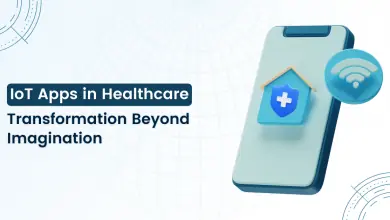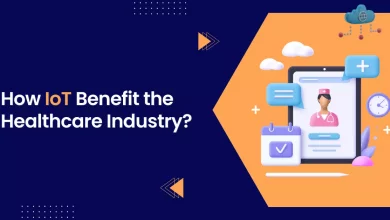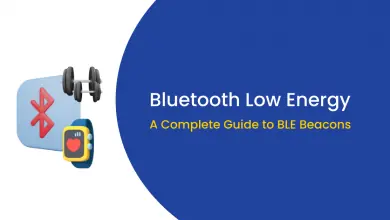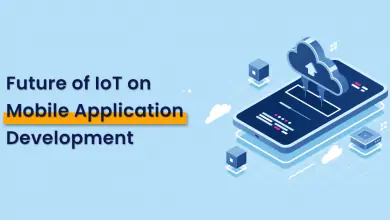A Comprehensive Guide To The Future Of IoT In The Automotive Industry
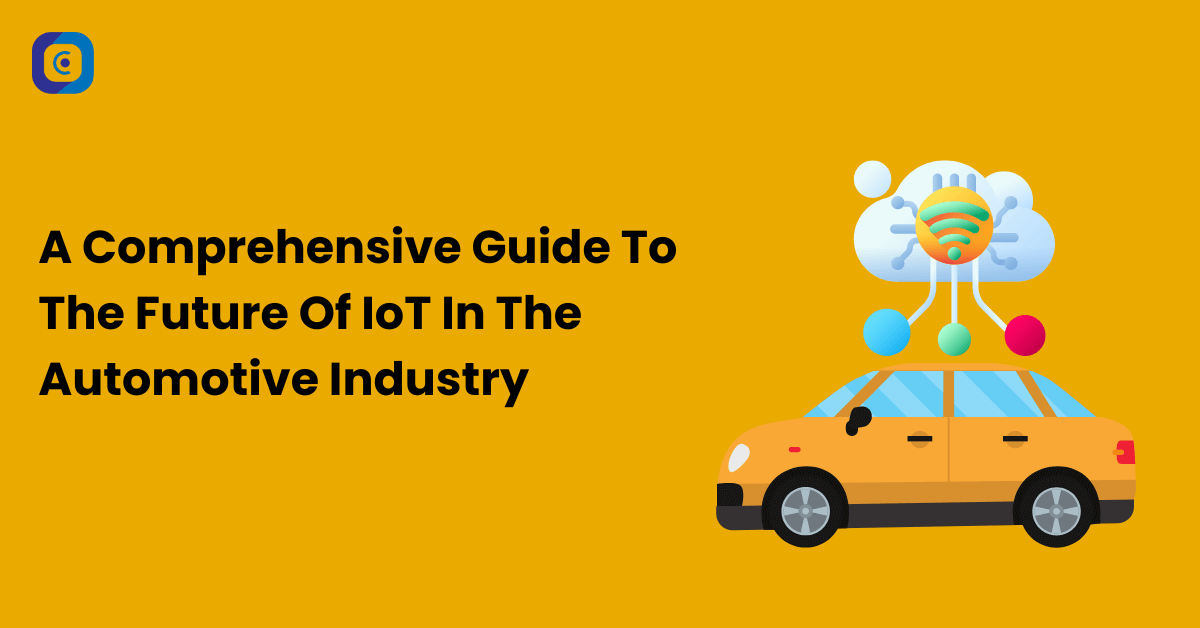
Are you ready to transform your automotive business with vehicles that go beyond transportation, becoming smart, connected networks? The Internet of Things automotive market is skyrocketing, from USD 102 billion in 2022 to an expected USD 811.72 billion by 2032. Let’s explore how automotive IoT solutions is catalyzing unprecedented innovation and efficiency within the automotive and logistics industries.No matter what you do in the car world, this IoT stuff is gonna change the game!
- Massive Market Growth: The Internet of Things automotive industry is about to hit the gas! We are witnessing a market surge from $102 billion in 2022 to a projected whopping $811.72 billion by 2032. That’s right, the hunger for IoT-powered vehicles is real.
- Safety on Autopilot: Automotive IoT solutions are revolutionizing the way vehicles operate, offering enhanced safety through autonomous driving capabilities and real-time diagnostics to prevent breakdowns before they occur.
- Beyond Just a Car: The future of driving isn’t just about the vehicle. Automotive IoT solutions are creating a connected ecosystem where cars, devices, and infrastructure work together seamlessly. Thanks to Internet of Things automotive, we can now provide a smoother, more efficient driving experience to our customers.
- Exponential Value Creation: By adopting automotive IoT solutions, the industry is seeing a transformative shift in value creation, influencing its development trajectory and offering new opportunities for innovation and competitiveness.
- Market Predictions: With Statista forecasting the global automotive IoT market to reach approximately $219.61 billion by 2026, the importance of automotive IoT solutions in driving the future of mobility cannot be overstated.
- The fast incorporation of IoT into vehicles is definitely a harbinger of technological progress. But more than that, the Internet of Things automotive is also introducing a new era of safer, more efficient, and more enjoyable transportation. No matter what you do in the car world, this IoT stuff is gonna change the game!
The Practical Role of Automotive IoT Solutions
The Internet of Things automotive solutions can revolutionize how vehicles operate, communicate, and interact with the world around them. Imagine your car not just as a means of transportation but as a smart device on wheels, equipped with a network of sensors, GPS trackers, cameras, and more, all seamlessly connected to the internet and each other. Here’s how it works and why it matters to you:
1. Connection of Complex Devices:
Your vehicle contains numerous devices like sensors that monitor engine performance, GPS trackers that help with navigation, and cameras for safety and security. With IoT, these devices are interconnected, enabling them to communicate and share data in real-time. This means your car can automatically adjust its route to avoid traffic jams or alert you to potential maintenance issues before they become serious problems.
2. Real-time Data and Cloud Connectivity:
All these devices send data to the cloud, where it’s processed and analyzed. This gives you access to real-time information about your vehicle’s performance, location, and condition. For instance, you can check your fuel level, tire pressure, or even the health of your engine from your smartphone, no matter where you are.
3. Seamless Operation:
Thanks to IoT, your vehicle can make smart decisions without your direct input. It can automatically adjust its speed based on traffic conditions, park itself, or even predict and react to potential hazards on the road. This level of automation not only makes driving safer but also more enjoyable and efficient.
4. Smarter, Safer, More Efficient Experiences:
IoT technologies in the automotive sector are creating new possibilities for enhancing driver and passenger experiences. From navigation systems that learn your preferred routes to entertainment systems that sync with your personal devices, IoT is making cars smarter and more responsive to your needs. Additionally, safety features like automatic emergency braking and predictive maintenance alerts can significantly reduce the risk of accidents and breakdowns.
IoT in automotive industry is about more than just adding technology to vehicles; it’s about transforming them into integrated platforms that offer unprecedented levels of intelligence, safety, and convenience.
Benefits of Integrating IoT Solutions in the Automotive Industry
Integrating IoT into your automotive services can significantly enhance operational efficiency and customer satisfaction. Here’s how various businesses within the automotive sector, both B2B and B2C, can benefit from these advancements:
1. Real-time Monitoring and Alerts:
- For Fleet Management Companies: You can monitor vehicle health, fuel levels, and tire pressure in real time, allowing you to address issues promptly, minimizing breakdown risks and improving safety. Early detection ensures your fleet remains operational, reducing unexpected downtime.
- For Vehicle Manufacturers and Dealerships: Offering vehicles equipped with IoT capabilities can be a strong selling point, showcasing your commitment to safety and innovation.
2. Enhanced Efficiency:
- For Logistics and Transportation Companies: By analyzing driver behavior and vehicle performance, you can optimize routes, reduce idle times, and enhance driver performance. This leads to higher efficiency and productivity, directly impacting your bottom line.
- For Insurance Companies: Utilizing data on driver behavior helps in tailoring insurance policies more accurately, potentially offering lower premiums for safer driving habits.
3. Optimized Route Planning
- For Delivery and Courier Services: Access to real-time traffic and weather data allows for dynamic route adjustment, avoiding delays and improving service reliability. This capability can significantly enhance customer satisfaction and operational efficiency.
- For Ride-Sharing and Taxi Services: This feature enables drivers to reach their destinations faster and more safely, enhancing passenger satisfaction and turnaround times.
4. Remote Vehicle Control and Management:
- For Car Rental and Leasing Companies: Offering customers the ability to remotely control and manage their rented or leased vehicles can significantly enhance the user experience, setting your services apart in a competitive market.
- For Automotive Security Providers: Implementing features like remote lock/unlock and engine start/stop can open up new service offerings focused on vehicle security and management.
5. Fuel Efficiency Optimization:
- For Fleet and Logistics Providers: Implementing strategies based on IoT data to reduce fuel consumption can lead to substantial savings, making your operations more sustainable and cost-effective.
- For Environmental Agencies and NGOs: Promoting the adoption of IoT technologies to optimize fuel use aligns with broader goals of reducing emissions and promoting sustainable transportation solutions.
6. Predictive Analytics and Maintenance:
- For Maintenance and Repair Service Providers: Offering predictive maintenance services based on IoT data can help you provide more value to your clients, ensuring their vehicles remain in optimal condition while minimizing unexpected repairs.
- For Vehicle Manufacturers: Incorporating predictive analytics into your vehicles not only enhances product quality but also provides a competitive edge by offering customers a more reliable and lower-maintenance product.

Exploring IoT Applications in the Automotive Industry
Within automotive operations, IoT solutions play a vital role. Let’s zoom in on the current applications that deliver tangible advantages to drivers, passengers, manufacturers, and fleet owners.
1. Automotive Manufacturing
In the world of automotive manufacturing, the integration of IoT (Internet of Things) applications is transforming how you, as a business, operate and succeed. Whether you’re a supplier, a technology provider, a logistics company, or directly dealing with consumers, IoT has something significant to offer. Let’s explore how these applications can benefit your business.
For Suppliers and Logistics Companies
IoT’s role in supply chain management revolutionizes how you handle inventory and logistics. Imagine your supply chain becoming more agile and resilient, capable of sensing, processing, and responding in real-time to the needs of the manufacturing process. This means you can make quicker, data-driven decisions about inventory movement, significantly reducing load times and inventory costs. The integration of cloud and AI technologies creates a “digital brain” for your supply chain, enhancing delivery times and overall efficiency.
For Technology and Software Providers
The advent of IoT-enabled predictive maintenance (PdM) is a boon. Your solutions can help automotive manufacturers minimize downtime by constantly monitoring equipment health and predicting failures before they happen. This not only cuts down maintenance costs but also improves operational efficiency, making the manufacturing process smoother and more reliable.
For B2C Companies (Dealerships, Insurance, and Finance)
IoT-based quality control and defect detection ensure the vehicles your customers receive adhere to the highest quality and safety standards. This technology enables the manufacturing process to minimize defects, ensuring excellence in vehicle development. For you, this means fewer customer complaints, lower return rates, and higher customer satisfaction. Your insurance company benefits from reduced risk, while finance companies can feel confident in the quality of the vehicles being financed.
IoT applications in automotive manufacturing open a door to a future where every aspect of the automotive sector, from supply chain management to the manufacturing floor to quality control, operates with greater intelligence, efficiency, and adaptability. Whether you supply raw materials, manufacture parts, handle logistics, or sell vehicles, IoT’s capabilities ensure that your business stays ahead in the fast-evolving automotive industry.
2. Connected Cars
Connected cars not only facilitate smoother and safer driving experiences but also offer environmental benefits by reducing fuel consumption and emissions through efficient route planning. For businesses, this translates into opportunities for developing new services, enhancing customer experience, and contributing to the broader goal of sustainable urban mobility. Here’s how connected cars, with their advanced communication capabilities, can be particularly beneficial for your business:
Vehicle to Infrastructure (V2I)
If your business deals with city planning or traffic management, connected cars can significantly enhance your operations. These vehicles can receive real-time updates from traffic lights and signs, helping to optimize traffic flow and reduce congestion. This means you can plan city infrastructure more effectively, ensuring smoother commutes for everyone.
Vehicle to Vehicle (V2V)
For automobile manufacturers and safety organizations, V2V communication opens up new avenues for enhancing road safety. By enabling cars to share safety-related information, you can develop systems that preemptively address potential accidents, making roads safer for drivers and reducing the risk of collisions.
Vehicle to Pedestrians (V2P)
Businesses focused on pedestrian safety, such as app developers and smart city solutions providers, can leverage V2P communication. By alerting drivers about pedestrians and vice versa, you’re contributing to a safer environment for road users, potentially reducing accidents involving pedestrians.
Vehicle to Cloud (V2C)
If you’re in the business of data analytics, cloud computing, or automotive software, V2C communication allows for the aggregation and analysis of vast amounts of data. This can lead to innovations in traffic management, personalized driver experiences, and even predictive maintenance services, offering new business opportunities and enhanced customer satisfaction.
Vehicle to Everything (V2X)
For companies that span across the automotive, telecommunications, and IoT sectors, V2X creates a comprehensive ecosystem where vehicles interact with their surroundings. This interconnectedness paves the way for smarter, safer, and more efficient transportation solutions, opening up myriad opportunities for innovation and service improvement.
3. Autonomous Vehicles
In the rapidly evolving world of automotive technology, the integration of IoT (Internet of Things) into autonomous vehicles is opening up a new frontier for businesses involved in this sector. Here’s how IoT applications in autonomous vehicles can significantly benefit your business:
Sensor Fusion and Perception
If your business is involved in manufacturing or developing technology for autonomous vehicles, like Honda, Volvo, or BMW, the role of IoT in enhancing sensor fusion and perception is paramount. Autonomous vehicles rely on an array of sensors to interpret their surroundings accurately. IoT technology enhances these sensors’ capability to detect obstacles and navigate safely, ensuring operation with utmost safety. For businesses, this means an opportunity to contribute to the cutting-edge of vehicle safety and navigation technology, potentially leading the market in developing safer, more reliable autonomous vehicles.
Predictive Analytics for Autonomous Driving
If your business is focused on enhancing the driving experience, IoT’s role in predictive analytics can significantly contribute. By collecting real-time data through sensors, AVs can generate a detailed map of their environment, recognizing road signs, traffic lights, and other vehicles. More importantly, this data helps predict the behavior of other road users, making autonomous driving safer and more efficient. For businesses developing intelligent traffic systems, this opens up opportunities for innovation in creating future-ready vehicles.
IoT-enabled Fleet Management and Optimization
For fleet owners, managers, and companies specializing in fleet solutions, IoT technology is revolutionizing fleet management. The shift towards ACES (autonomous, connected, electric, and shareable) fleets is backed by IoT, enhancing fleet monitoring, and optimization. This means you can leverage IoT for predictive maintenance, efficient route planning, and comprehensive asset and cargo management. The benefits extend to improved service efficiency, reduced waste, and enhanced safety for both passengers and drivers through advanced telematics solutions.
Business Implications
- Automotive Manufacturers and Tech Companies: You’re at the cutting edge of integrating sensor fusion and perception technologies, enhancing the safety and reliability of AVs.
- Innovation and Development Teams: Your work in predictive analytics can shape the future of autonomous driving, offering safer and smarter transportation solutions.
- Fleet Management Businesses: IoT enables you to optimize operations, reduce costs, and improve safety, positioning your fleet as modern, efficient, and competitive.
4. Automotive Cybersecurity
In the rapidly advancing world of automotive technology, the integration of IoT (Internet of Things) is not just enhancing vehicle capabilities but also playing a crucial role in safeguarding them against cyber threats. Here’s how IoT can bolster cybersecurity measures for your business within the automotive sector.
IoT-based Intrusion Detection and Prevention
If your business revolves around automotive manufacturing or cybersecurity solutions, implementing IoT-based Intrusion Detection Systems (IDS) is essential. These systems monitor for any unauthorized access or external attacks, immediately alerting OEMs (Original Equipment Manufacturers) and enabling swift action to mitigate risks. This means you can assure your customers of the security of their vehicles against cyber threats, enhancing trust and reliability in your brand.
IoT-powered Secure Communication Protocols
For businesses specializing in connected vehicle technologies, ensuring secure communication between the vehicle and external networks is paramount. IoT facilitates the use of authenticated and encrypted communication protocols, protecting against man-in-the-middle attacks and eavesdropping. This level of security is critical in maintaining the integrity of vehicle data and safeguarding user privacy, making your products more appealing to security-conscious consumers.
IoT-enabled Over-the-Air (OTA) Updates and Patches
As vehicles become more connected, the ability to remotely update software becomes an attractive feature. However, this also introduces vulnerabilities. IoT can streamline the process of delivering OTA updates securely, using standards like Uptane to protect against tampering and other cyber threats. For businesses in the automotive OS market, adopting robust OTA security frameworks ensures that your vehicles can safely receive updates, keeping the automotive software current and secure against emerging threats.

Challenges and concerns in automotive IoT implementation
Integrating IoT in automotive services presents unique challenges that can affect a range of businesses, from vehicle manufacturers and software developers to insurance companies and infrastructure providers. Here are some specific challenges and practical solutions:
1. Cybersecurity Challenges:
- Affected Businesses: Vehicle manufacturers, technology and software providers, insurance companies.
- Challenge: As vehicles become more connected, they are equipped with numerous IoT devices that can potentially serve as entry points for hackers. The complexity of securing these interconnected systems can be daunting. A breach not only risks the safety of passengers but also jeopardizes consumer trust in connected car technology. Manufacturers and service providers must invest significantly in cybersecurity measures, which can be costly and require continuous updates against evolving threats.
- Real-World Scenario: Suppose a hacker exploits a vulnerability in a vehicle’s communication system, gaining control over its brakes and steering, leading to a potential accident. Alternatively, personal data such as location and driving patterns are accessed and sold to third parties without consent.
- Solution: Businesses must adopt multi-layered cybersecurity strategies, including end-to-end encryption of data transmission, regular penetration testing to identify vulnerabilities, and the implementation of secure boot and secure firmware updates to protect against unauthorized software modifications. Educating consumers about cybersecurity hygiene, such as regularly updating their vehicle’s software, can also mitigate risks.
2. Interoperability Challenges:
- Affected Businesses: Automotive parts and component suppliers, technology and software providers.
- Challenge: In the automotive sector, vehicles often need to communicate with devices from multiple manufacturers, each potentially using different protocols and standards. This lack of uniformity can hinder the seamless exchange of information, complicating the integration of services like traffic management systems or vehicle diagnostics tools. Achieving interoperability requires concerted efforts to adopt universal standards, which can be a slow and complex process involving numerous stakeholders.
- Real-World Scenario: A fleet management company utilizes vehicles from different manufacturers, but struggles to integrate data across systems due to incompatible communication protocols, leading to inefficient fleet monitoring and management.
- Solution: Promoting the adoption of universal standards such as Automotive Grade Linux or GENIVI for automotive software can ensure compatibility across different manufacturers. Businesses can also invest in middleware solutions that act as a bridge between different protocols, enabling seamless data exchange and integration.
3. Integration with Existing Infrastructure:
- Affected Businesses: Logistics and transportation companies, city planners, infrastructure developers.
- Challenge: Many existing infrastructures were not designed with connected or autonomous vehicles in mind. Upgrading these systems to support IoT applications requires significant investment and coordination between public and private sectors. Delays in infrastructure upgrades can limit the functionality and benefits of connected vehicles, affecting everything from traffic flow optimization to emergency vehicle routing.
- Real-World Scenario: Connected vehicles are ready to communicate with smart city infrastructure, but the city’s traffic lights and road signs are outdated and not equipped for digital communication, leading to missed opportunities for traffic optimization.
- Solution: Public authorities and private companies should collaborate to upgrade urban infrastructure, installing IoT-enabled traffic management systems that can communicate with connected vehicles. Pilot projects in designated areas can demonstrate the benefits of such upgrades, helping to secure further investment.
4. Ethical and Social Considerations:
- Affected Businesses: Vehicle manufacturers, software developers, policymakers.
- Challenge: Ethical and social considerations can lead to public resistance and regulatory challenges. For instance, the use of data collected by vehicles raises privacy concerns, while the potential for increased surveillance may alarm citizens. Additionally, the prospect of autonomous vehicles replacing jobs in driving and logistics sectors can cause social unrest. Addressing these issues requires transparent policies and ethical guidelines, which can be complex to formulate and implement.
- Real-World Scenario: An autonomous vehicle faces an unavoidable accident and must choose between endangering its occupants or a pedestrian. The decision-making algorithm’s criteria for such scenarios raise ethical questions.
- Solution: Establishing transparent ethical guidelines for autonomous vehicle decision-making processes is crucial. Engaging the public, ethicists, and industry experts in discussions to define acceptable guidelines and programming vehicles to follow these can help address ethical dilemmas. Additionally, ensuring data privacy through robust consent mechanisms and data protection policies can mitigate privacy concerns.

5. Liability in Case of Accidents:
- Affected Businesses: Insurance companies, legal firms, vehicle manufacturers.
- Challenge: The blurring lines between human and machine responsibility complicate legal frameworks and insurance models. Developing regulations that fairly assign liability while encouraging innovation in autonomous vehicle technology is a significant challenge, requiring adjustments to existing laws and possibly creating new legal standards.
- Real-World Scenario: An autonomous car malfunctions due to a software glitch, causing a collision. Determining liability becomes complex, involving the vehicle manufacturer, software provider, and possibly the driver or vehicle owner.
- Solution: Updating legal frameworks to account for autonomous vehicles is essential. This might include creating a new category of liability that considers the role of software and hardware manufacturers in accidents. Insurance companies should also develop new products that cover the unique risks of autonomous vehicles, potentially incorporating data from the vehicles themselves to assess liability accurately.
6. Data Ownership and Usage:
- Affected Businesses: Vehicle manufacturers, service providers, consumers.
- Challenge: As connected cars generate vast amounts of data, disputes can arise over ownership and usage rights. Consumers may be concerned about privacy and data misuse, while manufacturers and third parties see value in utilizing data for improvement and personalization of services. Establishing clear data governance policies that balance these interests while protecting user privacy is essential but can be difficult to achieve.
- Real-World Scenario: A connected car collects detailed information about the driver’s habits, location, and preferences. The car manufacturer wants to use this data to improve services, but the driver is concerned about privacy and data misuse.
- Solution: Implementing clear data governance policies that define who owns the data collected by connected vehicles and how it can be used is essential. These policies should ensure drivers have control over their data, including the right to opt-out of data collection or to delete their data. Ensuring transparency in data usage and employing strong data encryption can help protect against unauthorized access and build trust with consumers.
Future of IoT in Automotive Industry
The future of IoT in automotive industry promises a transformative shift towards more connected, efficient, and intelligent transportation systems. As we navigate through the challenges and leverage the potential of IoT technologies, several key trends and developments are likely to shape the automotive landscape:
1. Enhanced Connectivity and Seamless Integration
The future will likely see an increase in vehicle-to-everything (V2X) communication capabilities, enabling cars to seamlessly connect with other vehicles, infrastructure, and devices. This interconnectedness will facilitate real-time traffic management, improve road safety, and optimize navigation through instant data sharing. Interoperability standards will become more unified, allowing for a cohesive ecosystem where vehicles from different manufacturers and various smart city systems can communicate effortlessly.
2. Advanced Autonomous Driving
IoT will play a crucial role in advancing autonomous driving technologies. With continuous improvements in sensor fusion, machine learning algorithms, and predictive analytics, self-driving cars will become safer, more reliable, and closer to widespread adoption. These advancements will not only enhance passenger convenience but also promise significant reductions in traffic accidents and fatalities. The ethical and liability issues surrounding autonomous vehicles will be addressed through clearer regulations and standards, paving the way for their integration into society.
3. Predictive Maintenance and Over-the-Air (OTA) Updates
IoT-enabled predictive maintenance will become standard, with vehicles capable of self-diagnosing and reporting potential issues before they lead to breakdowns. OTA updates will ensure that vehicle software remains up-to-date with the latest features and security patches, much like how smartphones operate today. This will extend the lifespan of vehicles, improve user experiences, and enhance cybersecurity measures.
4. Personalized and Enhanced User Experiences
The future of IoT in automotive will bring more personalized driving and ownership experiences. Vehicles will learn driver preferences and adapt to individual needs, from adjusting seat positions and climate control to suggesting routes and entertainment options. Integration with wearable devices and home automation systems will allow for a more connected lifestyle, where your car is an extension of your digital ecosystem.
5. Sustainable and Smart Mobility Solutions
IoT will drive the automotive industry towards more sustainable solutions. Electric and hybrid vehicles will become more prevalent, supported by smart charging networks that optimize energy consumption and reduce emissions. Shared mobility services, powered by IoT technologies, will offer flexible and eco-friendly alternatives to vehicle ownership, contributing to reduced traffic congestion and lower carbon footprints.
6. Data-Driven Business Models
The wealth of data generated by connected vehicles will enable new business models and revenue streams. From customized insurance policies and vehicle-as-a-service offerings to data-driven insights for urban planning and targeted marketing, the possibilities are vast. Ensuring data privacy and ownership rights will be critical in realizing the full potential of these models.

Final Thoughts
The future of IoT in automotive industry is poised to revolutionize how we perceive and interact with transportation. In the blog, we talked about several challenges that represent a significant hurdle in the widespread adoption and integration of IoT technologies in the automotive industry. Addressing them requires a multidisciplinary approach, involving technical innovation, regulatory updates, and ethical considerations, to ensure that the benefits of connected and autonomous vehicles can be fully realized without compromising safety, privacy, or societal norms. By overcoming those challenges and leveraging the opportunities IoT technologies offer, the automotive sector can look forward to a future that is not only technologically advanced but also safer, more sustainable, and deeply integrated into our digital lives.
At OneClick, we understand the dynamic landscape of the automotive industry. Our expertise in IoT technology empowers automotive manufacturers to unlock new levels of efficiency, safety, and customer satisfaction. Whether you’re aiming to enhance vehicle connectivity, streamline production processes, or offer groundbreaking services to your customers, OneClick is your ideal partner for achieving game-changing transformation.
Our team of skilled developers and innovators specializes in harnessing the power of IoT to create solutions tailored to the unique needs of the automotive sector. From predictive maintenance and advanced diagnostics to personalized in-vehicle experiences and beyond, our IoT-enabled solutions are designed to propel your business into the future. Contact us today to explore how we can drive your business forward.


